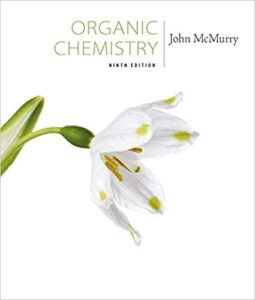Description
Test Bank For Organic Chemistry 9th Edition by John E. McMurry
Exhibit 6-1
Classify each reaction below as a(n):
a. addition
b. elimination
c. substitution
d. rearrangement
Place the letter corresponding to the correct answer in the blank to the left of the reaction.
1. _____
ANSWER: c
POINTS: 1
2. _____
ANSWER: d
POINTS: 1
3. _____
ANSWER: a
POINTS: 1
Exhibit 6-2
Identify the functional groups present in each compound below and predict the direction of polarity in each.
4. mustard gas Cl−CH2CH2−S−CH2CH2−Cl
ANSWER:
POINTS: 1
5.
ANSWER:
POINTS: 1
Exhibit 6-3
Classify each structure below as a nucleophile or electrophile and briefly explain your choice.
6.
ANSWER: Azide is a nucleophile since it has a net negative charge (and lots of electron pairs!).
POINTS: 1
7.
ANSWER: Hydronium ion is an electrophile since it has a positive charge.
POINTS: 1
8.
ANSWER: Phenol can be a nucleophile or an electrophile
POINTS: 1
Exhibit 6-4
Identify the nucleophile and electrophile in each reaction below and label them.
9.
ANSWER:
POINTS: 1
10.
ANSWER:
POINTS: 1
11.
ANSWER:
POINTS: 1
Exhibit 6-5
Add curved arrows to the following reactions to indicate the flow of electrons in each.
12.
ANSWER:
POINTS: 1
13.
ANSWER:
POINTS: 1
14.
ANSWER:
POINTS: 1
15. Acidic ether cleavages are typical substitution reactions. Use the information in Table 6.3 of the textbook to calculate ΔH° for the reaction of ethyl methyl ether with hydrogen chloride and hydrogen iodide.
a.
b.
Which acid would you predict to be most effective at ether cleavage?
ANSWER: a. CH 3CH2OCH3 + HCl CH3CH2OH + CH3Cl
Bonds broken Bonds formed
CH3CH2O−CH3 339 kJ/mol CH3CH2O−H 436 kJ/mol
H−Cl 432 kJ/mol CH3−Cl 351 kJ/mol
771 kJ/mol 787 kJ/mol
ΔH° = ΔH° bonds broken −ΔH° bonds formed = 771 − 787 kJ/mol
= −16 kJ/mol
b. CH3CH2OCH3C + HI CH3CH2OH + CH3I
Bonds broken Bonds formed
CH3CH2O−CH3 339 kJ/mol CH3CH2O−H 436 kJ/mol
H−I 298 kJ/mol CH3−I 234 kJ/mol
637 kJ/mol 670 kJ/mol
ΔH° = ΔH° bonds broken −ΔH° bonds formed = 637 − 670 kJ/mol
= −33 kJ/mol
Since cleavage with HI is the most exothermic we would predict that HI would be most effective at ether cleavage.
POINTS: 1
Exhibit 6-6
MATCH each definition to one of the terms below. Place the letter of the term in the blank to the left of the definition.
a. polarization f. substitution
b. addition reaction g. nucleophile
c. homolytic bond breakage h. radical reaction
d. electrophile i. elimination reaction
e. polar reaction j. heterolytic bond breakage
16. _____ A process involving symmetrical bond breaking and bond making.
ANSWER: h
POINTS: 1
17. _____ This occurs when both bonding electrons remain with one product fragment.
ANSWER: j
POINTS: 1
18. _____ A reaction where two reactants exchange parts to give two new products.
ANSWER: f
POINTS: 1
19. _____ A general term for species which have electron rich sites that can form a bond by donating a pair of electrons to an electron poor site.
ANSWER: g
POINTS: 1
Exhibit 6-7
Consider this reaction when answering the following question(s):
20. Refer to Exhibit 6-7. This reaction is an example of:
a. a substitution reaction.
b. a rearrangement reaction.
c. an addition reaction.
d. an elimination reaction.
ANSWER: b
POINTS: 1

Reviews
There are no reviews yet.